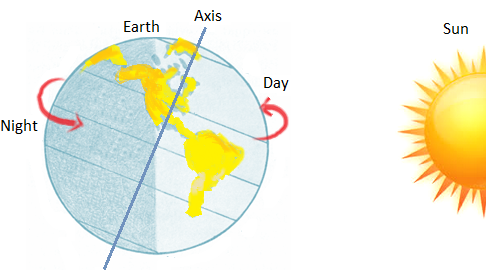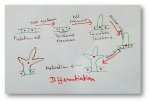Rotatory Motion of the Earth
We will discuss about the rotatory motion of the earth. Suppose, if we spin a top, it rotates around its pointed end. Just like the top, our earth moves all the time spinning on its own axis, from west to east.
The imaginary line passes through the north and south poles of the Earth is called the axis of rotation. This spinning movement of the Earth is called rotation. The earth completes one rotation on its axis in about 24 hours (i.e. one day and one night).
Due to its spherical shape, half of its spherical area gets light from the sun and the other half remains in the dark. For about 12 hours one half area of the earth is lighted while the other half remains dark during the same period. We say there is day in half of the sphere for about 12 hours and in the same period there is night in the other half. The next twelve hours, the position would be reversed, i.e. there will be night in the first half and day time in the second. Days are warmer while nights are cooler.
As the earth rotates from west to east, the sun seems to rise in the east and set in the west. At noon when the sun comes over our head, it gets too hot while in morning and evening we do not feel so hot. Thus, daily rotation of the earth affects the weather.
From Rotatory Motion of the Earth to HOME PAGE
Recent Articles
-
Differentiation, Dedifferentiation and Redifferentiation | Definition
Apr 21, 25 01:16 PM
Cells from the root apical meristem and shoot apical meristem the camera that differentiate , mature to perform different functions. This process by which the cells undergo different major structural… -
Explain about Growth in Plants |Definition of Growth & Differentiation
Feb 27, 25 02:07 PM
Growth is a permanent increase in length or volume of an organism that brought upon by an increase in its dimensions due to synthesis of new protoplasmic material. -
Definition of Respiratory Quotient | calculation | Application | Plant
Dec 02, 24 12:09 AM
Definition of respiration quotient- the ratio of the carbon-dioxide evolved to that of the oxygen consumed by a cell, tissue, plants or animals in a given time is called respiratory quotient. It is us… -
Amphibolic Pathway | Definition | Examples | Pentose Phosphate Pathway
Jun 06, 24 10:40 AM
Definition of amphibolic pathway- Amphibolic pathway is a biochemical pathway where anabolism and catabolism are both combined together. Examples of amphibolic pathway- there are different biochemical… -
Respiratory Balance Sheet | TCA Cycle | ATP Consumption Process
Feb 18, 24 01:56 PM
The major component that produced during the photosynthesis is Glucose which is further metabolised by the different metabolic pathways like glycolysis, Krebs cycle, TCA cycle and produces energy whic…





New! Comments
Have your say about what you just read! Leave me a comment in the box below.